Could you live with a motorcycle as your SOLE MEANS of transportation? Commuter, errand runner, weekend getaway tool? I've done it, and it's not that big of a deal. Of course, I was in my 20s, lived in Southern California, and was single at the time, but nonetheless my trusty 1993 Honda CBR900RR and I navigated the insanity of Hollywood and not only survived but loved every second of it.
We decided to examine three forms of commuter transportation, break down their associated costs, and try to prove what most people in the rest of the world already know: Motorcycles provide a lot of bang for your buck when it comes to pure transportation and are considerably more fun the rest of the time.
Personally, this whole concept of only using a motorcycle for transportation is no longer possible for me, as I have two young kids who are six and four, live in the ’burbs, and without owning a bike with cavernous luggage can’t pull off the Costco runs without a car/truck. But let's see how the costs add up and look at the fun factor...
For the sake of balance, we’ll break this down into two different parts: a week of commuting and a fun weekend destination. Since there is a Metrolink/Amtrak station just a quarter mile from the Bonnier Motorcycle Group offices, this will be our home base. A typical SoCal commute is around 20 miles, so we’ve picked San Clemente to the south, as that is also the last Metrolink stop on the Orange County line.
Our weekend destination will be San Diego (80 miles via Amtrak), for a lot of reasons but primarily because it has a lot of craft breweries (Ballast Point, Green Flash, The Lost Abbey, and Stone, to name a tiny fraction), has a compact and walkable downtown, and is easily accessed by rail.
Now, for our selection of vehicles: Since we are motorcycle people let's start with the winner of our sub-400cc entry-level sportbike comparison last year, the $4,990 Yamaha YZF-R3. And since we are motoheads, we selected a car company that also makes motorcycles, of which there are only a few. So we selected a Honda Fit EX, which as delivered lists for $18,520 (Honda didn't have a press fleet LX, which starts at $15,890 with a manual transmission).
MOTORCYCLE
Introduced in 2015, the Yamaha YZF-R3 entered a market segment dominated for more than two decades by the Kawasaki Ninja 250/300 and that Honda had only recently entered with the CBR250R/300R. KTM's RC390 also joined the game last year. But in testing the R3 proved to be the most well rounded in the group.
Powered by a 321cc parallel twin, the R3 put out 36.8 hp at 10,800 rpm with 19.8 pound-feet of peak torque at 9,110 rpm on the Cycle World dyno. With a dry weight of just 349 pounds, the engine provides enough power for spirited riding for experts and yet isn't intimidating for newer riders. More to the point, the R3 registered an average of 57 mpg during our testing and with a 3.7-gallon fuel tank should get around 200 miles per fill-up.
What else makes a motorcycle like the R3 inexpensive to operate? Insurance and payments, of course. A quick look online at prosper.com gave us a loose idea of what payments would be. The R3’s retail price is $4,990, so we calculated a 36-month loan at 6.0 percent APR, with $500 down, giving us a monthly payment of $135. I did an insurance quote with Progressive Insurance, and to be fair it may be skewed a bit, as I’m a married, 47-year-old male, with a clean driving record (how the hell did that happen?), yielding a quote of around $44 per month for full coverage.
AUTOMOBILE
It's been a while since I'd last driven a true economy car. I drive a full-size diesel van when I need four wheels, and even our corporate rental allowance gets us a midsize. So I really had no idea what to expect from the Fit EX. Right off the bat, the Honda had a few positive things going for it: It has a six-speed manual transmission and a really good infotainment system with Bluetooth Audio and HandsFreeLink phone connection. But my favorite feature is the LaneWatch camera (mounted on the right mirror) that is activated when you turn on your right turn signal, offering an incredible view of your blind spot on the center console's 7-inch display. This would be interesting tech to try on motorcycles because we still get a lot of motorcycles with marginally useful rearview mirrors.
With a claimed 130 hp from its 1.5-liter DOHC 16-valve i-VTEC four, the Fit is no rocket ship, but it proved fun to drive. It averaged 31.4 mpg, which equates to a range of approximately 330 miles between fill-ups.
Clearly, the Fit is going to be more expensive to operate than the R3, but compared to other automobiles it is quite affordable. Plugging our test car’s $18,520 price tag into a loan calculator for 48 months, $2,000 down, and at Honda’s 2-percent APR, it spit out a monthly payment of $361. Then we did another online quote with Progressive Insurance with me as the primary driver, which came back at $96 per month.
TRAIN
Southern California has a laughable public transportation network. This region has long been dominated by freeways and automobiles. Railways, subways, and other mass people movers were afterthoughts. A prime example is that you cannot take a train to LAX, one of the busiest airports in the world! But if you happen to live in the right part of LA/Orange County, there are still useful commuter lines.
Anyone who commutes via train buys a monthly pass, so we priced one based on the stations listed and got $211 a month. This doesn’t take into account that most of the stations on the OC line still require that you either drive a car, ride a motorcycle, or hitch a ride to the station. Commuter parking is free, but it’s not like you can take a subway to get to the train station.
For our weekend excursion, the round-trip fare to downtown San Diego is $48. But that assumes we would rely on our feet, cabs, or Uber once there, the latter two options costing us added money.
THE COMMUTE
Our sample weekly commute works out to 200 miles. First we'll break down the costs to ride the Yamaha: Our calculations put us at 3.5 gallons of fuel for the week at $3.19 per gallon for super unleaded (Orange County average), equating to around $11.20 a week. Then we broke down the R3's cost of ownership for that same five-day span and came up with $29.83 including loan and insurance. So our grand total for the week on the motorcycle is $41.03. For the Honda, we plugged in the same mileage and got fuel costs of $18.15 per week, with a cost of ownership of $76.16 including loan and insurance, for a total of $94.31. The train was the cheapest at $35.16, but the hassle hardly seems worth the effort when you could own the Yamaha for just about a Lincoln note more.
Our weekend trip made the figures even more black and white. The 80-mile round trip to San Diego on the R3 only uses around 2.8 gallons of fuel at a cost of $9, while cost of ownership for the day is a paltry $6, for a total of $15. The Honda Fit uses 5.1 gallons of fuel at $14.55, while a day’s ownership sets you back around $15.25, for a total trip cost of $29.80. The train, as mentioned, was $48.
CONCLUSION
The motorcycle trounced the other two forms of transportation by a large margin—as we expected—and proves that an inexpensive, cheap-to-insure bike is an economical choice. But the cost of ownership and fuel prices would change dramatically if we were talking about a BMW S1000RR, H-D Street Glide, or KTM Super Adventure. Also, if you live somewhere with an actual winter, it's not a year-round solution. As for the car, it hauls kids in car seats and has enough trunk space to load up with groceries for said kids. At this point in my life, I still need one of these cage things. As for the train, it's a great option at times, like when you want to drink beer, or when your motorcycle has a flat tire, or when your car is in for service.
But for our purposes, the bike wins on every level: A motorcycle is not only a blast to ride on the weekend, but it can make that dreary commute the best part of your day. What other form of transportation can accomplish that?










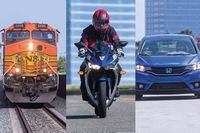
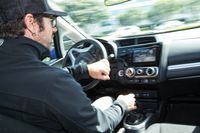

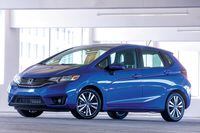
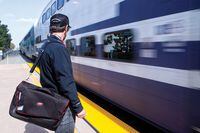

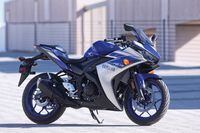
/cloudfront-us-east-1.images.arcpublishing.com/octane/AUE3NFVRRZDSBIDVUGIYIDQNUI.jpg)
/cloudfront-us-east-1.images.arcpublishing.com/octane/LYR62CH2WNBMHJJVXVATZHOUE4.jpg)
/cloudfront-us-east-1.images.arcpublishing.com/octane/RBCTRGBQYBDK7A6XPG3HKPS7ZQ.jpg)
/cloudfront-us-east-1.images.arcpublishing.com/octane/MQXQRYMZVBCWJIRYP3HEN3SHVE.jpg)
/cloudfront-us-east-1.images.arcpublishing.com/octane/TSPODNNEWRDSVJGUCNQTDG4ADI.jpg)
/cloudfront-us-east-1.images.arcpublishing.com/octane/X5TB7BDV4BA2RPSY54ZGK27RP4.jpg)
/cloudfront-us-east-1.images.arcpublishing.com/octane/REUHOJXRDBGZ5IHBYZCCBCISPA.jpg)
/cloudfront-us-east-1.images.arcpublishing.com/octane/52LGJTCKBFEHDF7S7H4CVUIMGM.jpg)
/cloudfront-us-east-1.images.arcpublishing.com/octane/YMWAIPIPSJAOXOU3QMJMGH37OM.jpg)


/cloudfront-us-east-1.images.arcpublishing.com/octane/EJ6KZRGAYBCVXNL2PJXL37UVWQ.jpg)
/cloudfront-us-east-1.images.arcpublishing.com/octane/AAN4TI76M5H5JMUVEIGASWXBDU.jpg)
/cloudfront-us-east-1.images.arcpublishing.com/octane/P3RXD2UCPFF37CMB7CHPVKXORY.jpg)
/cloudfront-us-east-1.images.arcpublishing.com/octane/VZEG2EJI2RDFZNHLRZMU56MD3Q.jpg)
/cloudfront-us-east-1.images.arcpublishing.com/octane/GVJQO5FFOFBWNGODOBRB4FBAW4.jpg)
/cloudfront-us-east-1.images.arcpublishing.com/octane/BIVAK2SFIBDJJM25E7I5VU2FJE.jpg)
/cloudfront-us-east-1.images.arcpublishing.com/octane/CH5VX52UG5CFHOVH5A6UYEFWWA.jpg)
/cloudfront-us-east-1.images.arcpublishing.com/octane/ZVGJNGZRU5C33N7KN23BBFKSC4.jpg)


/cloudfront-us-east-1.images.arcpublishing.com/octane/CZ5OM3E43ZEXJHY7LCYXCHLIKI.jpg)
/cloudfront-us-east-1.images.arcpublishing.com/octane/DF5T4K5KPZFJXFCTGPYR77PKJM.jpg)
/cloudfront-us-east-1.images.arcpublishing.com/octane/RMCT2KVQBJHBZMRTSLOVPMOILU.jpg)